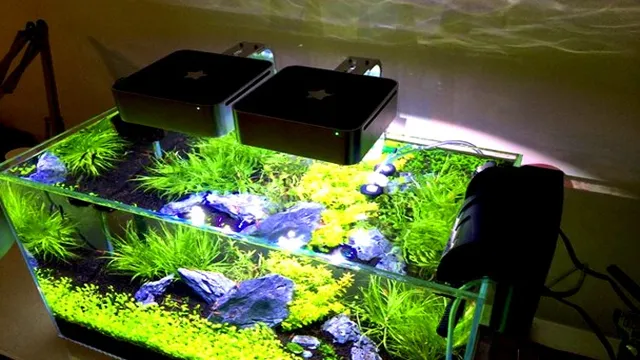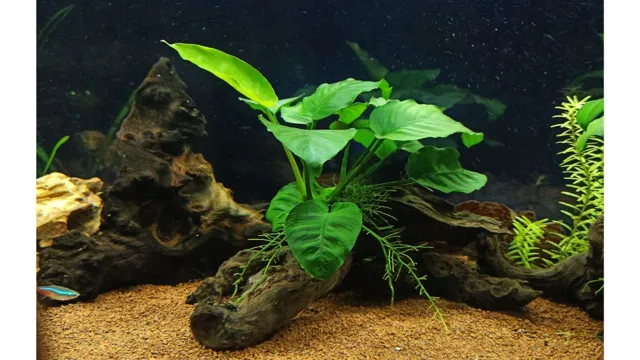If you are an aquarist, then you know how important lighting is for the well-being of your aquatic pets and plants. LED lights have become increasingly popular in recent years due to their energy efficiency and flexibility. However, with the wide variety of LED lights available in today’s market, choosing the right one for your aquarium can be a daunting task.
Fear not, as we have got you covered! In this blog, we will walk you through a few essential factors that you should consider before purchasing LED lights for your aquarium. By the end of this blog, you will be equipped with the knowledge to make an informed decision about the best LED lights for your aquarium. So, let’s dive in!
Understanding Light Requirements for Aquarium Plants and Fish
To determine the right LED light for your aquarium, you need to understand the lighting requirements of your aquatic plants and fish. Different plants have different requirements, and it’s important to find a light that can provide the necessary spectrum and intensity that they need to thrive. Similarly, the type and number of fish in your tank can also impact your lighting needs.
Some fish may be more sensitive to bright lights, while others may require a higher intensity. It’s essential to strike a balance between providing sufficient light for your plants and fish while avoiding any potential harm. So, before investing in LED lights for your aquarium, be sure to research the specific requirements of your aquatic inhabitants and choose a light that can meet their needs adequately.
Types of Aquarium Plants
When it comes to maintaining a thriving aquatic ecosystem, understanding the light requirements of your aquarium plants and fish is crucial. Different aquarium plants have varying needs when it comes to light intensity, duration, and quality. For example, low-light plants such as Java fern and Anubias can thrive with just a few hours of indirect light each day, while high-light plants like Amazon sword and dwarf baby tears require bright, direct lighting for several hours a day.
It’s also important to keep in mind that some fish, such as bettas and discus, prefer dimmer lighting while others, such as tetras and guppies, prefer brighter lighting. By taking the time to research the light requirements of your specific aquatic plants and fish, you can create an environment that promotes growth and health for all of your aquarium inhabitants.

Types of Fish
When it comes to creating a thriving aquarium, it’s important to understand the light requirements of both your plants and fish. Different species have varying needs when it comes to lighting, and understanding these requirements can be crucial to their health and survival. For example, aquarium plants generally need high levels of light to thrive, while certain species of fish may prefer dimmer lighting conditions.
It’s important to research the specific needs of the plants and fish you plan to keep in your tank to ensure they receive the appropriate amount of light. Providing too much or too little light can not only harm your plants and fish, but it can also upset the delicate balance of your aquarium ecosystem. By taking the time to understand and cater to the lighting needs of your plants and fish, you can create a vibrant and beautiful underwater world that thrives for years to come.
Factors to Consider When Choosing LED Lights
When choosing LED lights for your aquarium, there are several factors that you need to consider to ensure that your fish and aquatic plants thrive in a healthy environment. Firstly, the size of your aquarium plays a critical role in determining the number and type of LEDs you need. Secondly, the light’s color temperature should mimic natural sunlight, which ranges from 5000K to 10,000K.
The intensity of light should also be adjusted according to your aquarium’s depth, and the type of plants you have, as some require more light than others. Lastly, opt for LED lights that come with a timer to prevent overexposure, and a dimmer that enables you to adjust the light’s brightness according to your preference. With these considerations in mind, you’ll be able to choose the perfect LED lights that will keep your aquarium ecosystem thriving.
Tank Size and Shape
When it comes to choosing LED lights for your aquarium, there are several factors to consider, starting with the size and shape of your tank. The type of LED light fixture you choose should be suitable for your tank size and shape. For instance, a circular tank would require a different fixture than a rectangular aquarium with the same volume.
The intensity of light also plays a significant role in the success of your aquatic plants and animals. If your tank is shallow, low-intensity LED lights may be sufficient, while taller tanks may need high-intensity lights to penetrate deeper into the water. Additionally, the type of LED, such as full spectrum or color-specific, will also affect the overall lighting of your tank. (See Also: How to Jellyfish Aquarium: A Beginner’s Guide to Creating a Stunning Underwater World)
By taking into consideration the tank size and shape, intensity of light, and type of LED light needed, you can choose the right LED fixture for optimal plant growth and animal health.
Intensity and Color Temperature
When it comes to choosing LED lights, there are a few factors to keep in mind. One of the most important things to consider is the intensity of the light. This refers to how bright the LED light is and is usually measured in lumens.
Another crucial factor is the color temperature of the light. Color temperature is measured in Kelvin and ranges from warm, yellowish tones to cool, bluish tones. The color temperature you choose will depend on the purpose of the light and the atmosphere you’re trying to create.
For example, a warm light might be better suited for a relaxing living room, while a cool light might be better for a workspace where you need to stay alert and focused. Overall, it’s important to think about your needs and preferences when choosing LED lights, and to experiment with different options until you find what works best for you.
Customization and Control
When choosing LED lights, there are several factors to consider to ensure that you get the right lighting for your needs. One important factor is customization and control. LED lights come with different brightness levels that can be controlled to suit your specific lighting requirements.
Some LED lights even come with features that allow you to change the color temperature and adjust the light’s brightness using remote control or a mobile app. Another crucial factor to consider is energy efficiency. LED lights use up to 75% less energy than traditional light bulbs, making them an excellent choice for anyone looking to reduce their electricity bills.
Additionally, LED lights last longer, which means that you won’t need to replace them as often, further reducing your expenses. Overall, when choosing LED lights, you should consider customization and control, energy efficiency, and longevity to find the best lighting for your needs.
Determining the Wattage and Lumens Needed
When it comes to determining the LED light needed for your aquarium, wattage and lumens are essential factors to consider. First, calculate the total water volume of your tank and then choose a wattage based on the recommended range of 0.5 to 1 watt per gallon.
Next, consider the type of plants or animals living in your aquarium and their specific lighting needs. This will help you determine the necessary lumens, which measure the amount of light emitted. A general rule of thumb is to aim for 20 to 40 lumens per gallon for a planted tank and 40 to 60 lumens per gallon for a reef tank.
Remember, it’s always better to have too much light than not enough, so don’t be afraid to go up in wattage or lumens if needed. By selecting the proper wattage and lumens for your aquarium, you can provide your aquatic life with the ideal environment to thrive. (See Also: How to Get Rid of Algae on Live Aquarium Plants: Effective Ways to Keep Your Tank Clean)
Calculating Wattage Needs
When it comes to selecting a light fixture, it’s important to determine the correct wattage and lumens needed to ensure that the space is well-lit and efficient. Wattage refers to the amount of electricity that the bulb consumes, while lumens measure the amount of light it produces. A general rule of thumb is to use around 20-30 lumens per square foot of space.
For example, a room that measures 10×10 feet would require approximately 2,000-3,000 lumens. However, it’s also important to consider the purpose of the room and the desired level of brightness. A task-oriented room such as a kitchen or home office may require more lumens, while a bedroom or living room may require softer lighting.
Additionally, consider energy-efficient options such as LED bulbs and dimmer switches to further customize your lighting needs while cutting down on energy usage. By considering these factors, you can select the perfect light fixture to meet your specific needs.
Calculating Lumens Needs
When it comes to lighting your space, it’s essential to determine the wattage and lumens needed to achieve the desired brightness. The wattage measures the amount of energy consumed by the bulb, while lumens indicate the brightness of the light emitted. To calculate the number of lumens required, consider the purpose of the space and the amount of light necessary.
For instance, a living room may need more lumens than a bedroom. A general rule of thumb is to aim for 20 lumens per square foot for a typical residential room. However, additional factors such as ambient lighting and personal preference should also be taken into account.
Using LED bulbs can also help reduce the wattage needed while still providing adequate lumens. By calculating the right wattage and lumens needed, you can create a well-lit, comfortable, and functional space that meets your lighting needs.
Final Considerations and Recommendations
Choosing the right LED light for your aquarium can be a daunting task, especially for those who are new to the hobby. The first thing to consider is the type of fish and plants you have in your tank. Different species have different lighting needs, and some plants or corals require more intense light than others.
Additionally, it’s important to choose a light fixture that fits the size and shape of your aquarium. The easiest way to determine the right LED light is to check the PAR (Photosynthetically Active Radiation) rating of the fixture. The PAR rating measures the amount of light that is usable by plants and corals for photosynthesis, so a higher PAR rating generally means better growth and health.
Finally, it’s important to choose a reputable brand with good reviews and to consider the cost of replacing bulbs or fixtures in the long run. With these factors in mind, you’ll be able to choose the perfect LED light for your aquarium and watch your fish and plants thrive.
Conclusion
In short, choosing the right LED light for your aquarium is not just a matter of wattage or the number of colors. It involves a careful consideration of your tank’s size and inhabitants, as well as the unique properties and benefits of different types of LEDs. So take your time, do your research, and don’t be afraid to ask for help from your friendly neighborhood fish store or online community of aquatic enthusiasts.
And remember, a well-lit and happy aquarium is a thing of beauty and wonder, so don’t settle for anything less than the perfect LED light for your aquatic oasis.” (See Also: How to Reset Aquarium Heater in Simple Steps: A Complete Guide)
FAQs
What factors should I consider when choosing LED lights for my aquarium?
When choosing LED lights for your aquarium, consider the size of your tank, the type of plants or fish you have, and the intensity and color spectrum of the LED lights.
How many LED lights do I need for my aquarium?
The number of LED lights you need for your aquarium depends on the size of your tank, the type of plants or fish you have, and the intensity of the LED lights. As a general rule, aim to provide 1-2 watts of LED lighting per gallon of water.
What is the ideal color temperature for LED lights in an aquarium?
The ideal color temperature for LED lights in an aquarium is between 6500K and 10,000K. This range of color temperature provides a natural-looking light that enhances the color of your fish and plants.
How long should I run my LED lights in my aquarium each day?
Most aquariums require 10-12 hours of light per day. However, the exact duration of LED light exposure depends on the plants and fish in your aquarium. Some aquatic plants require up to 14 hours of light per day, while others require less.
Can I use LED lights for both freshwater and saltwater aquariums?
Yes, LED lights can be used for both freshwater and saltwater aquariums. However, it is essential to choose LED lights that are appropriate for the type of aquarium and the plants or fish in it.
What is the lifespan of LED lights for aquariums?
The lifespan of LED lights for aquariums varies depending on the brand and quality of the product. However, most LED lights can last between 30,000 to 50,000 hours, which translates to about 3-5 years of continuous use.
Do LED lights produce heat, and will it raise the temperature of my aquarium?
LED lights do produce some heat, but it is minimal compared to other types of lighting. This small amount of heat is unlikely to raise the temperature of your aquarium significantly. However, it is always best to monitor your aquarium’s temperature to ensure it stays within the appropriate range.







